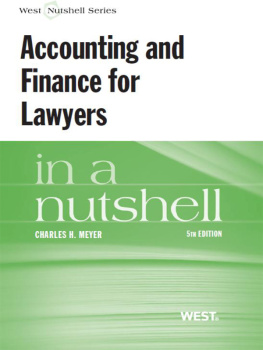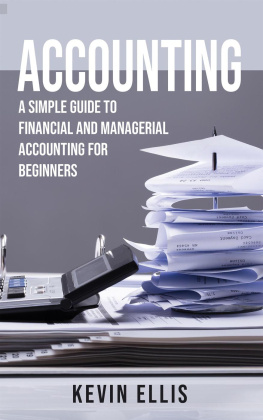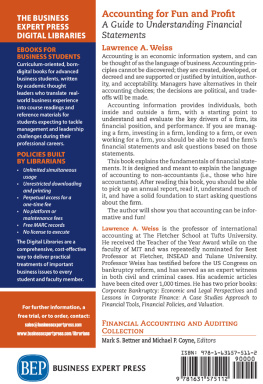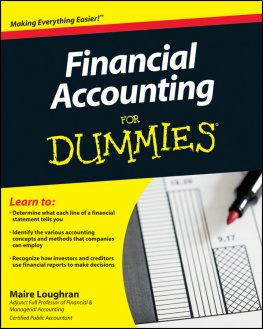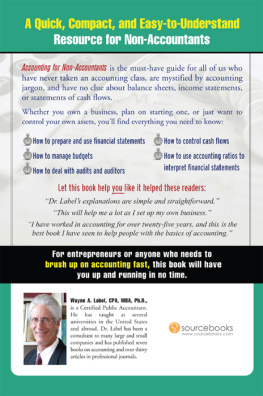Landmarks
Page list

WESTS LAW SCHOOL
ADVISORY BOARD
__________
JESSE H. CHOPER
Professor of Law and Dean Emeritus,
University of California, Berkeley
JOSHUA DRESSLER
Professor of Law, Michael E. Moritz College of Law,
The Ohio State University
YALE KAMISAR
Professor of Law Emeritus, University of San Diego
Professor of Law Emeritus, University of Michigan
MARY KAY KANE
Professor of Law, Chancellor and Dean Emeritus,
University of California,
Hastings College of the Law
LARRY D. KRAMER
President, William and Flora Hewlett Foundation
JONATHAN R. MACEY
Professor of Law, Yale Law School
ARTHUR R. MILLER
University Professor, New York University
Formerly Bruce Bromley Professor of Law, Harvard University
GRANT S. NELSON
Professor of Law, Pepperdine University
Professor of Law Emeritus, University of California, Los Angeles
A. BENJAMIN SPENCER
Professor of Law,
Washington & Lee University School of Law
JAMES J. WHITE
Professor of Law, University of Michigan
I
ACCOUNTING AND FINANCE FOR LAWYERS
IN A NUTSHELL
FIFTH EDITION
By
CHARLES H. MEYER
Senior Vice President
Taxes and Senior Tax Counsel
GE Capital Aviation Services

Mat #41337719
II
Thomson Reuters created this publication to provide you with accurate and authoritative information concerning the subject matter covered. However, this publication was not necessarily prepared by persons licensed to practice law in a particular jurisdiction. Thomson Reuters does not render legal or other professional advice, and this publication is not a substitute for the advice of an attorney. If you require legal or other expert advice, you should seek the services of a competent attorney or other professional.
Nutshell Series, In a Nutshell and the Nutshell Logo are trademarks registered in the U.S. Patent and Trademark Office.
COPYRIGHT 1995 WEST PUBLISHING CO.
West, a Thomson business, 2002, 2006
2009 Thomson Reuters
2013 Thomson Reuters
610 Opperman Drive
St. Paul, MN 55123
1-800-313-9378
Printed in the United States of America
ISBN: 9780314285645
III
To
Joseph and Lisa Meyer
V
FOREWORD TO THE FIFTH EDITION
__________
The accounting world and accounting rules continue to change reflecting both changes in the business environment and refined thinking about how transactions and events should be presented in financial statements. The fifth edition reflects the key developments that have occurred since the fourth edition.
As in the case of both the third and fourth editions, the FASB adopted further changes to the rules regarding transfers of receivables and servicing rights and obligations, which continues to be a hot topic. Chapter 5 has been updated to reflect these further changes.
Changes to the rules for the consolidation of variable interest entities were duscussed in the fourth edition. Since then, the FASB has continued to refine these rules.
Since the rules regarding goodwill created in connection with business acquisitions were amended to require an annual quantitiative impairment review for goodwill rather than an automatic amortization of goodwill, companies have been concerned about the time and cost involved in performing these impairment reviews. As discussed in Chapter 8, the FASB has introduced a new concept for testing goodwill. VI A company now first undertakes a qualitative assessment to determine if it is more likely than not that an impairment of goodwill has occurred. If that is not the case, it is not necessary to undertake the quantitative testing of goodwill for impairment.
The requirement to present total comprehensive income in addition to the traditional net income continues to receive focus by the FASB. The FASB adopted new standards allowing companies to elect between preparing one continuous statement that presents both net income and comrephensive income or preparing two statements, one for net income and one immediately following that presents other comprehensive income and comes to a total that includes all the components of comprehensive income.
Aside from these substantive changes, one of the biggest developments in accounting in the United States was the issuance by the FASB of a codification of accounting standards that came out while the fourth edition was in production. The individual FASB statements and interpretations and other sources of official accounting guidance in the United States have been incorporated into a consolidated set of accounting rules. The FASB now periodically issues accounting standards updates that amend the codification. The fifth edition has been revised to reflect the new citations to the codification. There is also a cross reference table in the appendix that cross references between the old FASB (and APB) pronouncement VII numbers that were covered prominently in prior editions and the new codification references.
As always, I trust that this fifth edition will continue to provide law students, lawyers, and other readers with a sufficient understanding of the basics of accounting and finance so that they can better appreciate the significance of accounting and its importance in the commercial and legal world.
CHM
Norwalk, CT
October 2012
IX
OUTLINE
__________
X
XI
XII
XIII
XIV
XV
XVI
XVII
XVIII
XIX
XX
XXI
XXII
XXIII
ACCOUNTING AND FINANCE FOR LAWYERS
FIFTH EDITION
CHAPTER 1
THE BASIC FINANCIAL STATEMENTS
The main subject matter of this Nutshell is financial accounting. Financial accounting involves the process of recording transactions in the accounting records of a business and periodically extracting, sorting, and summarizing the recorded transactions to produce a set of financial statements. Financial statements are the primary means by which businesses communicate financial information to various users. When a business issues a complete set of financial statements, there are four individual statements that are typically prepared. This chapter will introduce and describe the basic financial statements. Various items and concepts introduced briefly in this chapter will be discussed in more detail in later chapters. A general familiarity with the output of the financial accounting process should assist in understanding the accounting process and the issues that arise in the preparation of the financial statements.
A. THE BALANCE SHEET
The balance sheet, also called the statement of financial position, sets forth the assets, liabilities, and owners equity (the investment of the owners) of a business as of a particular point in time (typically, the end of the fiscal Year). The balance sheet is a snapshot as of the date it is issued. A sample balance sheet is shown in Exhibit 1.1. In a typical balance sheet, the assets are listed on the left hand side. On the right hand side are listed the liabilities of the business and the owners equity accounts.
Exhibit 1.1
Balance Sheet


